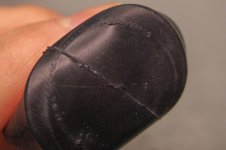mrbill
10 kW
Folks:
I've got an ongoing problem with loosening axle nuts.
I'm using a medium-power Nine Continents M3006RC as sold (but now discontinued) by Grin:
http://www.ebikes.ca/shop/discontinued/m3006rc.html
and on both left and right dropouts, Doctorbass's hardened steel torque arms:
https://endless-sphere.com/forums/viewtopic.php?f=31&t=29129&start=300#p698328
The motor axle is 12mm with 10mm flats. Thread is M12x1.25. The bolts are serrated flange nuts, probably made of mild steel by the look of it. Although I don't have vast experience with a wide variety of hub motor axles, I suspect this is pretty standard for motors of this size and rating.
The dropout slot in the torque arm is just a tad over 10mm to facilitate insertion and removal of the axle, so there is a tiny bit of rotational play. This play can be observed as an audible "clunk" when torque is reversed from regen to driving mode and vice-versa. When the axle bolt on one side or the other comes finger-loose, the "clunk" noise takes on a sharper "tink" or "tap" noise.
Various sources recommend maximum torque for M12 nuts (usually 1.5mm threads) ranging from around 80 to 130 Nm, depending on the hardness of the nut. I've tightened these to 60Nm, and that feels quite tight to me for a nut/thread this size, especially considering that the nut is only engaging threads around half the axle (the other half being the flat). I don't want to damage the threads.
But after a hundred miles of riding the nuts are loose again to the point of clunking. After a few hundred more miles of riding, the axle nuts are finger-loose. I now carry an 18mm offset wrench with me on the bike.
I'm suspicious that the serrated flange nut being softer metal compared to the hard surface of the torque arm can't get any bite into the surface of the torque arm, so it slides easily and given repeated axle torque reversals, works its way loose.
What axle nut torque is sufficient to prevent nut loosening?
Would there be any benefit to roughening the nut flange-facing surface of the torque arm?
Thanks.
I've got an ongoing problem with loosening axle nuts.
I'm using a medium-power Nine Continents M3006RC as sold (but now discontinued) by Grin:
http://www.ebikes.ca/shop/discontinued/m3006rc.html
and on both left and right dropouts, Doctorbass's hardened steel torque arms:
https://endless-sphere.com/forums/viewtopic.php?f=31&t=29129&start=300#p698328
The motor axle is 12mm with 10mm flats. Thread is M12x1.25. The bolts are serrated flange nuts, probably made of mild steel by the look of it. Although I don't have vast experience with a wide variety of hub motor axles, I suspect this is pretty standard for motors of this size and rating.
The dropout slot in the torque arm is just a tad over 10mm to facilitate insertion and removal of the axle, so there is a tiny bit of rotational play. This play can be observed as an audible "clunk" when torque is reversed from regen to driving mode and vice-versa. When the axle bolt on one side or the other comes finger-loose, the "clunk" noise takes on a sharper "tink" or "tap" noise.
Various sources recommend maximum torque for M12 nuts (usually 1.5mm threads) ranging from around 80 to 130 Nm, depending on the hardness of the nut. I've tightened these to 60Nm, and that feels quite tight to me for a nut/thread this size, especially considering that the nut is only engaging threads around half the axle (the other half being the flat). I don't want to damage the threads.
But after a hundred miles of riding the nuts are loose again to the point of clunking. After a few hundred more miles of riding, the axle nuts are finger-loose. I now carry an 18mm offset wrench with me on the bike.
I'm suspicious that the serrated flange nut being softer metal compared to the hard surface of the torque arm can't get any bite into the surface of the torque arm, so it slides easily and given repeated axle torque reversals, works its way loose.
What axle nut torque is sufficient to prevent nut loosening?
Would there be any benefit to roughening the nut flange-facing surface of the torque arm?
Thanks.


